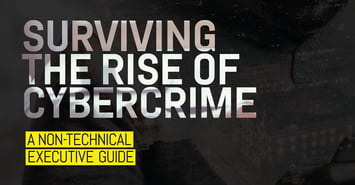These are interesting times to be in business. The fastest pace of industrial development in history. Huge opportunities. Huge risks. An economic environment that rewards innovation but is also incredibly volatile.
I’ve been working on my priority shortlist this week, figuring out what flags to plant in my strategy for 2018.
As I was reading forecasts and speculative commentary on business trends, a few recurring themes started to stand out: technology investment; cybersecurity; and committed customer relationships.
I’ve plunged down the rabbit hole of economic forecasting, blog speculation and commerce futurism and I’ve resurfaced with what I think are the 4 Key Business Priorities for 2018
#1: Reputation Driven Growth
Even companies that aren’t in high-tech industries need to be evolving the way they sell. People buy everything online now, from groceries to insurance. The internet is the shopfront, the advertising media and the platform for transactions - it’s the way we find and engage with our customers.
Social commerce and value-based marketing have matured into powerful tools that are available to all businesspeople.
Putting resources into building online brands is one of the safest investments around, right now. In a marketplace infested with one-hit-wonders, half-baked ideas and fraud, consumers gravitate toward brands with reputational substance and robust user ratings.
It’s not a new idea that good products are good for business, but social media and interactive retail have created a business environment where it’s much harder for unscrupulous companies to hide product inadequacy behind hype.
If you haven’t already made this a priority, 2018 is the time to double-down on your reputation to fuel business growth. The unprecedented transparency of the marketplace is directly related to item #2 on my priority list; subscription sales models.
#2: Subscription Sales Models
Subscription-based business is part of the formula for so many of the most successful companies around, right now. It’s part of the new commercial landscape that the internet has created and it’s a great fit for digital products.
Consumers are adopting subscription products en-masse - think Netflix or Dollar Shave Club - but the most impressive evidence of the way subscription works is the emergence of SaaS products like Office 365 and Salesforce as ubiquitous leaders in their fields.
Obviously, I’m a believer in the SaaS model; my company MailGuard is a SaaS product vendor.
SaaS and subscription based businesses generally have more predictable revenue structures; for CxOs that means increased stability and simplified financial planning.
SaaS is also a winning architecture for business people because it provides outstanding value for our clients. As SaaS providers, we can strategically adapt to our customers changing needs; and when they see ongoing evidence that a company is looking out for their interests, customers become loyal partners. But you don’t need to take my word for it; according to Deloitte research the cloud services market will be worth US$547 billion by the end of 2018, which is based on growth rates over recent years of between 20-40%.
SaaS and subscription based businesses can focus on providing value to build sticky client relationships, instead of relying on advertising to constantly recruit new customers.
Longer term relationships are great value for clients and they’re also the key to rock solid financial forecasting and maximised brand prestige.
#3: Cybersecurity
 It’s clear that cybersecurity is near the top of many CEO’s priority lists.
It’s clear that cybersecurity is near the top of many CEO’s priority lists.
Securing our online platforms is vital not only to avoid disruptions but also to foster confidence in our customer base and maintain a positive corporate image.
To do business efficiently we need secure infrastructure. Cybercrime attacks that result in damage to computer systems and data breaches are becoming more and more common and the associated costs to companies are escalating rapidly.
Recently conducted research by the FBI’s cybersecurity division and reports from independent cybersecurity experts estimate the projected cost of cybercrime in 2018 at more than US$12 billion dollars.
The current aggressive growth of cybercrime makes it the most prescient threat facing companies, both large and small. Cybercrime can inflict massive immediate financial losses on businesses, but it also has the effect of eroding confidence - in your supply chain, amongst investors, and with your customers. Demonstrating to customers that we can handle their business in a secure environment is a fundamental plank of a business relationship. If we fail to secure our systems properly we’re making ourselves vulnerable to theft but we also risk losing the trust and confidence of our customers.
We’ve already seen dramatic examples of what happens when criminals break into commercial systems. Incidents like the Uber breach, WannaCry and Petya underline the crucial importance of building resilient defences and Governments are now seeking to mandate corporate cybersecurity standards.
This year two major data-security regulatory regimes are being brought in.
On February 22 the Australian Government introduces the Notifiable Data Breach (NDB) Scheme.
Australian companies that collect customer data will be required to notify people if their credit card records or other sensitive data is stolen by cybercriminals. If a company fails to fulfil their NDB obligations there are legal and financial penalties.
The EU’s GDPR regulations will come into effect in May, as well. The GDPR rules provide harsh financial penalties for companies that allow personal information to be hacked or stolen.
GDPR and NDB are evidence that governments recognise the seriousness of the cybercrime threat. But as someone with a close-up POV on this issue, I can attest that a lot of businesspeople don’t give enough thought to cybersecurity. Cybercrime against companies is booming but the level of preparedness is not yet keeping pace.
#4: Emergent Technology
In the last 12 months, new technology like augmented reality, IOT and voice-tech went from being novelty items to mainstream product categories. This mass-adoption of new tech is part of the larger trend economists are calling ‘Industry 4.0’; a generational economic change driven by integrated technology.
According to PwC research, Industry 4.0 investment is ramping up already; they estimate US$907 billion p/a spent by companies through 2020. A big chunk of that spending is expected to be focused on digital technologies like connectivity devices, software and applications.
Rather than seeing Industry 4.0 as a threat, we should recognise that the digital revolution is a huge business opportunity. PwC forecasts that industry 4.0 investment will yield a return within two years or less.
Industry 4.0 isn’t just a new way of doing things, it’s a new way of perceiving business priorities.
As business leaders, I think we need to be more focused on innovation than ever before but we also have to be fully aware of the changing risk management challenges we face. The efficiency, viability and security of our companies hinges on our willingness to accept the realities of the online world.
The digital generation gap is a reality. Growing cybercrime is a reality.
The marketplace we’re doing business in now places a premium on data security. Companies who demonstrate they are prepared to innovate in the online space without exposing themselves to unnecessary risk will gain a big reputational advantage going forward.
Whatever business we’re in we should be seizing every opportunity to engage with new tech. The Industry 4.0 phenomenon is creating a generational gap in manufacturing and provision of services. To be on the right side of this gap we need to be adopting emergent technology and making it secure so we can reap all the benefits of the new marketplace.
Join the Conversation
I’d like to hear what 2018 looks like from your POV. What’s on your priority list?
Please get in touch with me on LinkedIn or Twitter.
 Craig McDonald is the author of Surviving the Rise of Cybercrime, a non-technical guide for executives. To learn more about solving the complex cybersecurity challenges we face today, download your free copy here.
Craig McDonald is the author of Surviving the Rise of Cybercrime, a non-technical guide for executives. To learn more about solving the complex cybersecurity challenges we face today, download your free copy here.






